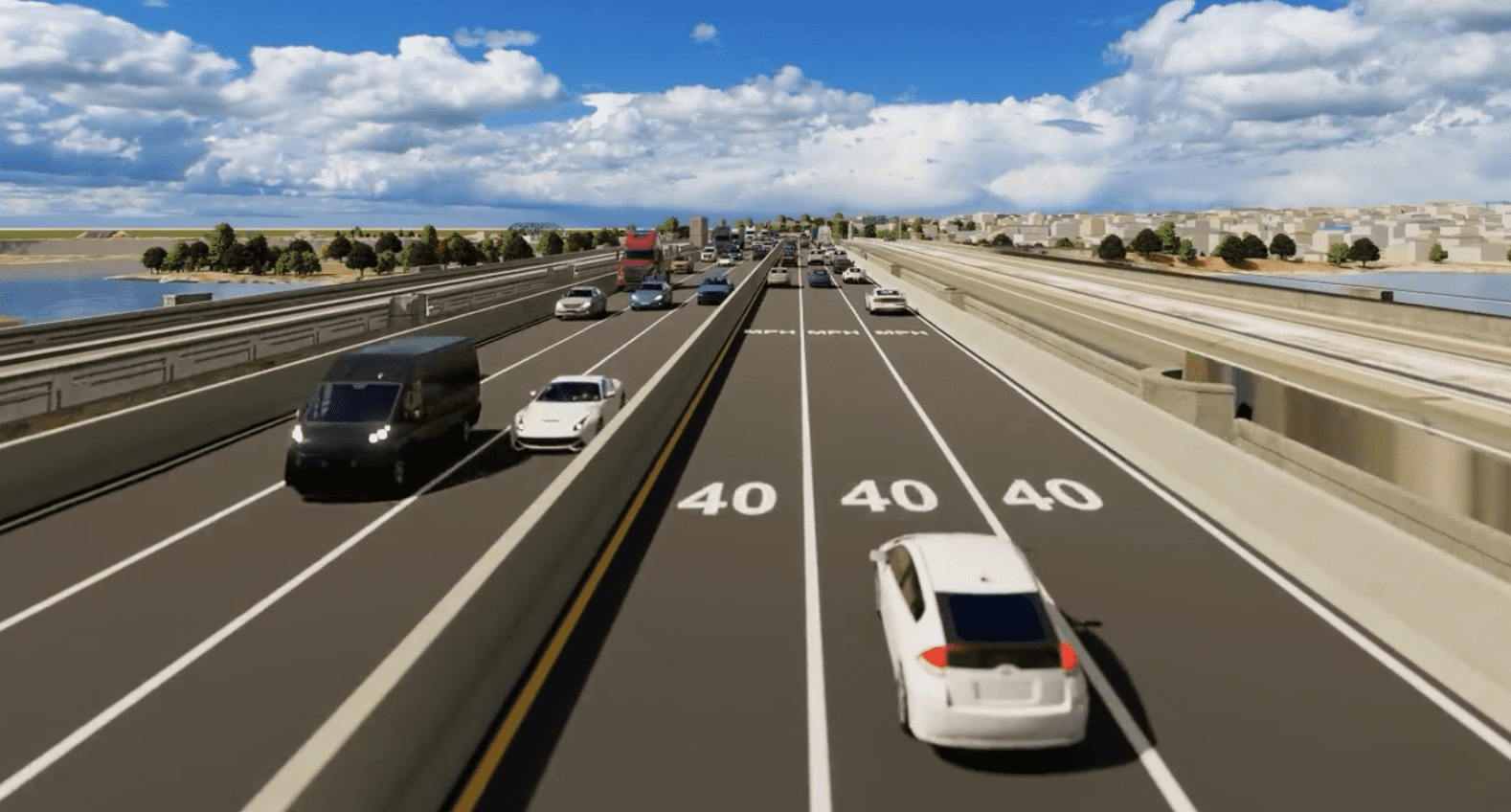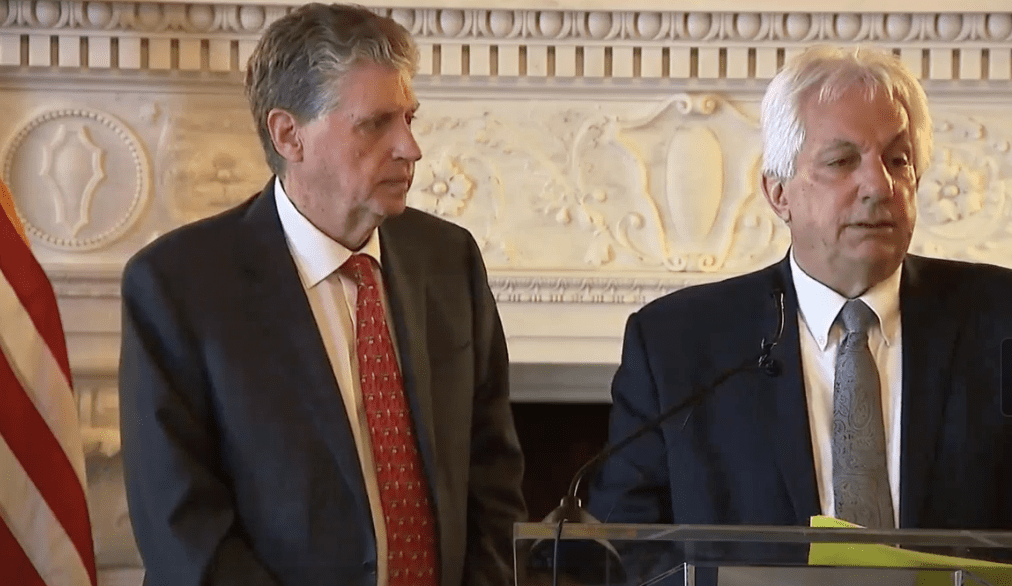Search Posts
Recent Posts
- In the News… recap of the week ending May 3, 2025 May 3, 2025
- Rhode Island Weather for May 3, 2025 – Jack Donnelly May 3, 2025
- Out and About in RI: 14th annual Alzheimer’s conference. Caregiving and research. May 3, 2025
- Real Estate in RI: Architectural ranch in Westerly, $1,265,000 with Residential Properties for seller May 3, 2025
- Burn with Kearns: Compete longer, injury-free, perform like a fighter, at any age – Kevin Kearns May 3, 2025
Categories
Subscribe!
Thanks for subscribing! Please check your email for further instructions.

Washington Bridge moving to 6 tight lanes – time for good situational awareness
Photo: RIDOT
Tonight’s the night – 3 lanes all the way around, East and West – on I-195. Crews will be working tonight – Friday night warning to those who took 2 hours to commute last Friday night. While RIDOT has said that “crews will be working on Friday night from 9 p.m. to early Saturday morning”, we know that delays can happen – last time 3 lanes were put in on the East side, the work was delayed right up until commute time.
The third lane will open westbound on the Washington Bridge on the morning of Saturday, April 20. This will provide three lanes of travel in both directions. The speed limit is 40 MPH.
Lanes will be only 10 feet wide, and trucks must use the far-right lane, which is 11 feet wide. Note: Not every truck is doing this on the East side of the highway which is already 3 lanes – and not every car is going to stay to a speed limit – and not every car is going to stay in their lanes without a swerve for whatever reason – so this is the time to drive defensively – and have good situational awareness.
RIDOT urges drivers to stay in their lane, avoid distractions, and be kind to one another.
Today, at 10am, Governor Dan McKee, Senior Deputy Chief of Staff Joseph Almond, Rhode Island State Police Superintendent Colonel Darnell Weaver, and Director of Transportation Peter Alviti will discuss safety and enforcement measures to maintain safe travel across the Washington Bridge.
This is a developing story and will be updated, as needed, after the press event.
Here is the link to the pool camera used for the Governor’s press event held this morning: No new information was presented, other than to reiterate that paying attention and not having distracted driving is critical and police will be patrolling to assist with accidents, trucks in the wrong lane, etc.

Governor’s statement from presser:
Today, Governor Dan McKee was joined by Senior Deputy Chief of Staff Joseph Almond, Rhode Island State Police (RISP) Superintendent Colonel Darnell Weaver, and Rhode Island Department of Transportation (RIDOT) Director Peter Alviti to promote safe travel practices in advance of the Saturday’s change to three lanes on the westbound side of the Washington Bridge.
Pointing to an increase in accidents on I-195 in the months immediately following the bridge failure, Governor McKee made clear his goal to reduce the number of accidents occurring on the Washington Bridge. The Governor is encouraging travelers to follow the reduced speed limit of 40 miles an hour, avoid switching lanes, and most importantly, stay alert and off cell phones.
“Our goal is to keep Rhode Islanders safe and get them where they need to go with the least amount of delay possible,” said Governor Dan McKee. “We know that in order to do both of those things successfully, we must all work together to reduce the number of accidents on the Washington Bridge, particularly those caused by distracted driving.”
“It’s tempting when you are sitting in traffic to take out that cell phone to check your texts. But it means you aren’t paying attention to your surroundings, and it means you are more likely to cause an accident that not only affects you, but the many hundreds of cars around you,” the Governor added.
In addition to increased safety signage on the bridge and PSA messaging, RISP has an increased presence on the bridge to help address distracted driving and prevent accidents.
Colonel Weaver spoke about the impact of distracted driving, saying, “Not only does distracted driving increase the likelihood of crashes, but it also reduces reaction times, impairs judgment and compromises situational awareness.”
This expanded effort to reduce accidents on the bridge comes after the state has taken steps to reduce the time to clear accidents on the bridge, so traffic snarls are alleviated sooner. Since the State began staging tow trucks along the route and ramping up its police presence on the bridge, the time to clear on the bridge has dropped from 30 minutes to 21 minutes.
The addition of a third lane on the westbound side of the Washington Bridge should shorten the time it takes to cross the bridge and ease some of the congestion in the surrounding towns. It may also reduce the number of accidents by eliminating some of the choke points where drivers have had to merge from three to two lanes.
This comes a little more than a week after RIDOT added a third lane to the eastbound side of the bridge. RIDOT, along with traffic engineering and structural engineering consultants and Federal Highway Administration (FHWA) traffic experts, has certified that the bridge structure is sufficient to carry the extra lanes.
Beginning at 9 p.m. on Friday, April 19, RIDOT will begin with changing the traffic pattern on I-195 East to provide three lanes of through travel on the Washington Bridge. RIDOT will restripe the highway during the evening and overnight hours, with change complete by 9 a.m. on Saturday, April 20.
The lanes on the westbound side will be reduced in width, just as the lanes on the eastbound side had been reduce in width last week. The left and center lanes will be 10 feet wide, and trucks will be restricted to the far-right lane, which will be 11 feet wide. RIDOT will post signage that trucks must use the far-right lane only.
It is important to note that because additional repaving and subsequent restriping are needed to improve the surface of the bridge, overnight work will be temporarily reducing the number of travel lanes between 9 p.m. and 6 a.m. for the first two weeks of the latest lane change.
Travelers looking to anticipate their travel time across the bridge can see average travel times for a number of different routes, depending on the time of day, by visiting www.washington-bridge.com.

The Federal Highway Administration has studied the impacts of narrowing driving lanes from 12 ft to 10 ft. Not surprisingly, narrowing lanes to 10 ft. increases the number of accidents (from other studies, from 30-70%), as well as slows the speed of traffic. 10 ft wide lanes work in slow speed urban areas with limited traffic volumes (less than 250 cars/day by some studies). They do NOT work on a high speed interstate highway with 100,000 vehicles/day. This is a sad attempt at window dressing by McKee and Alviti, to let them say they’re ‘doing something.’ While we need to think out of the box to try and find ways to mitigate this disaster, we should only implement measures that actually make sense and improve conditions, not make them worse.
https://safety.fhwa.dot.gov/geometric/pubs/mitigationstrategies/chapter3/3_lanewidth.cfm
what a shit show. we are narrowing the lanes and we know it is unsafe and there will be accidents. good luck, wear your helmet